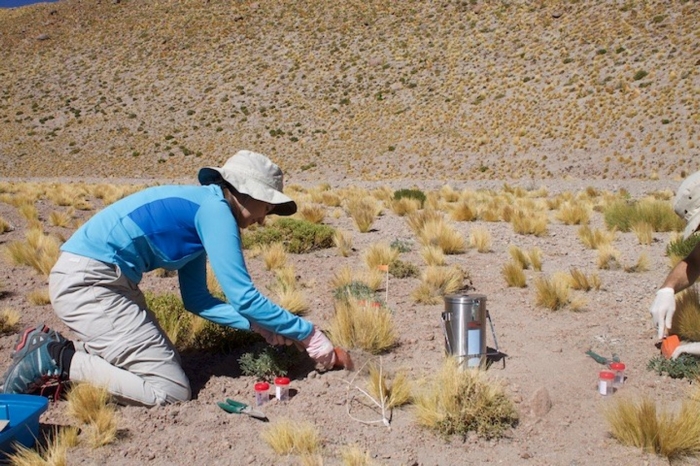It's not easy for life in Chile's unforgiving Atacama desert: a harsh, hostile place renowned for being the planet's driest non-polar desert.
Yet against the odds, life somehow survives in these barren badlands, which have a history of farming stretching back thousands of years.
Identifying the mechanisms behind these unlikely successes is a task that's more important today than perhaps ever before, as it could reveal the secrets of making food grow in a world becoming hotter and drier with every passing year.
In a new study, scientists have discerned some of those hidden tricks, discovering the genetic underpinnings of a range of adaptations that enable plant life to prosper even in the withering, extreme conditions of the Atacama desert.
 Researcher Gabriela Carrasco studies plant samples in the Atacama Desert. (Melissa Aguilar)
Researcher Gabriela Carrasco studies plant samples in the Atacama Desert. (Melissa Aguilar)
"In an era of accelerated climate change, it is critical to uncover the genetic basis to improve crop production and resilience under dry and nutrient-poor conditions," says plant systems biologist Gloria Coruzzi from New York University.
Over a period of 10 years, Coruzzi and an international team of researchers studied Atacama plant life in 22 sites within the desert landscape, both in situ, and off site as well – carefully ferrying plant and soil samples back to the lab, frozen in liquid nitrogen to preserve them for genomic analysis.
In total, 32 of the most dominant plants in the desert had their transcriptomes sequenced, which were then compared with 32 closely related species from other locations, none featuring genetic adaptations to Atacama's environment.
"The goal was to use this evolutionary tree based on genome sequences to identify the changes in amino acid sequences encoded in the genes that support the evolution of the Atacama plant adaptation to desert conditions," Coruzzi says.
The comparison technique – an example of what's called phylogenomics – yielded 265 positively selected genes, suggesting they correlated with mutations that might confer advantages in the Atacama desert.
Further analysis revealed 59 of these genes also show up in one of the most-studied model organisms in plant biology, Arabidopsis, in which they have been linked to physiological and molecular processes that can enhance plant resilience in extreme environmental conditions, the researchers say.
In other words, these genes – which are positively selected in Atacama desert plants – are already known to enable Arabidopsis to withstand high radiation and temperature stress, regulate floral development and flowering time, help defend against pathogens, and assist with water and nutrient uptake.
From the sounds of it, that almost reads like an evolutionary toolkit for how to survive as a plant in one of the most inhospitable environments on Earth, and the good news is that some of the same genetics can be found in food crop species too – which means we might have a better idea of what crops to plant where as the world warms, and also how best to breed, tweak, and future-proof them.
The work "is directly relevant to regions around the world that are becoming increasingly arid, with factors such as drought, extreme temperatures, and salt in water and soil posing a significant threat to global food production," says senior author and plant systems biologist Rodrigo Gutiérrez from the Pontifical Catholic University of Chile.
"As some Atacama plants are closely related to staple crops, including grains, legumes, and potatoes, the candidate genes we identified represent a genetic goldmine to engineer more resilient crops, a necessity given the increased desertification of our planet."
The findings are reported in PNAS.
#Nature | https://sciencespies.com/nature/genetic-goldmine-in-earths-harshest-desert-could-be-the-key-to-feeding-the-future/
No comments:
Post a Comment